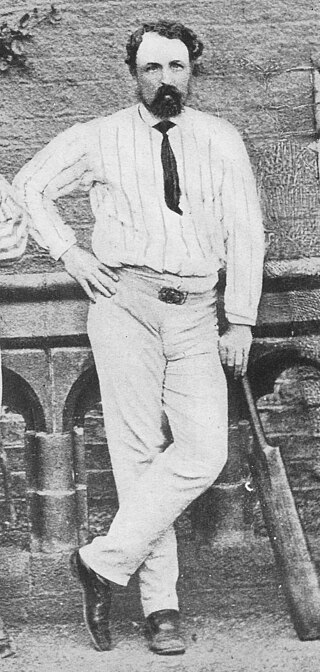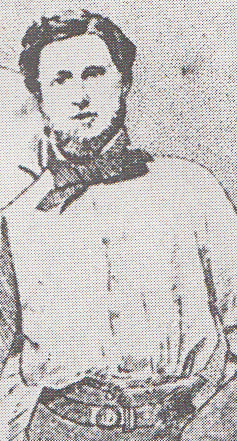Related Research Articles

Kent County Cricket Club is one of the eighteen first-class county clubs within the domestic cricket structure of England and Wales. It represents the historic county of Kent. A club representing the county was first founded in 1842 but Kent teams have played top-class cricket since the early 18th century, and the club has always held first-class status. The current Kent County Cricket Club was formed on 6 December 1870 following the merger of two representative teams. Kent have competed in the County Championship since the official start of the competition in 1890 and have played in every top-level domestic cricket competition in England. The club's limited overs team is called the Kent Spitfires after the Supermarine Spitfire.
Arthur Haygarth was a noted amateur cricketer who became one of cricket's most significant historians. He played first-class cricket for the Marylebone Cricket Club and Sussex between 1844 and 1861, as well as numerous other invitational and representative teams including an England XI and a pre-county Middlesex. A right-handed bat, Haygarth played 136 games now regarded as first-class, scoring 3,042 runs and taking 19 wickets with his part-time bowling. He was educated at Harrow, which had established a rich tradition as a proving ground for cricketers. He served on many MCC committees and was elected a life member in 1864.

George Anderson was an English cricketer, who played first-class cricket for Sheffield Cricket Club from 1850 to 1862 and then for Yorkshire County Cricket Club from its inception in 1863 until 1869.
In English cricket since the first half of the 18th century, various ad hoc teams have been formed for short-term purposes which have been called England to play against, say, Marylebone Cricket Club (MCC) or an individual county team. The key factor is that they were non-international and there is a significant difference between them and the official England cricket team which takes part in international fixtures. Conceptually, there is evidence of this sort of team being formed, or at least mooted, since the 1730s. They have always been "occasional elevens" but, nevertheless, have invariably been strong sides. A typical example would be a selection consisting of leading players drawn from several county teams.

Frederick William Lillywhite was an English first-class cricketer during the game's roundarm era. One of the main protagonists in the legalisation of roundarm, he was one of the most successful bowlers of his era. His status is borne out by his nickname: The Nonpareil.
William Ayling was an English cricketer who played in 22 first-class cricket matches between 1800 and 1810.

William Josiah Sumner Hammersley was an English-born first-class cricketer and sports journalist in Victoria, Australia, one of the four men credited with setting down the original rules of Australian rules football.
John Collard Cocker, known as Joe Cocker, was an English cricketer who played a single first-class cricket match for a Kent XI in 1842. He was a key figure in the development of cricket in South Australia after emigrating to the colony in the 1840s and was the first curator of the Adelaide Oval.
Walter Fellows was an English amateur cricketer who later became a clergyman in Australia. He was the brother of Harvey Fellows, who also played first-class cricket.
John Deedes was an amateur English first-class cricketer.
Henry Arkwright was an English amateur first-class cricketer. He made seventeen appearances between 1858 and 1866. He is one of only three cricketers to have taken 18 first-class wickets in a match.
Charles Edward Horner was an English cricketer who played first class cricket for Oxford University from 1877 to 1880 and for Surrey from 1882 to 1886.
William Percival Pickering was an English first-class cricketer with amateur status. He was one of the founders of Surrey County Cricket Club in 1845 and later, having emigrated to Canada, played a significant role in the beginnings of international cricket especially through his proposal to fund an English tour of North America. Pickering is recorded in 29 matches from 1840 to 1848 which are designated first-class by CricketArchive, totalling 445 runs at the low average of 9.67 with a highest score of 51 not out, holding 17 catches and taking 7 wickets.
William Napper was an English cricketer active in the 1840s and 1850s, making over sixty appearances in first-class cricket. Born at Sparr Farm, Wisborough Green, Sussex, Napper was a left-handed batsman and right-arm roundarm slow bowler, who played for several first-class cricket teams.
George Henry Withers Ewbank was an English cricketer. Ewbank's batting and bowling styles are unknown.
Alfred Smith was an English cricketer notable for his fourteen first-class cricket appearances for Sussex as a gentleman cricketer between 1841 and 1852.
Walter Attewell was an English cricketer active in first-class cricket in the 1890s, making five appearances for four different teams.
Frederick William Bell was an English first-class cricketer and umpire.
In English cricket, the years 1846–1863 were the main period of the sport's "roundarm era". Although roundarm had been legalised amid great controversy, its timespan was relatively short. By 1863, there was an increasing demand for the legalisation of overarm bowling and this was achieved on 10 June 1864.
References
- ↑ "Player Profile: William Hammond". ESPN CricInfo. Retrieved 22 November 2013.
- 1 2 3 "Player Profile: William Hammond". Cricket Archive. Retrieved 22 November 2013.
- ↑ Carlaw D (2020) Kent County Cricketers A to Z. Part One: 1806–1914 (revised edition), pp. 202–203. (Available online at the Association of Cricket Statisticians and Historians. Retrieved 7 August 2022.)
- ↑ "TEAMS WILLIAM HAMMOND PLAYED FOR". Cricket Archive. Retrieved 22 November 2013.